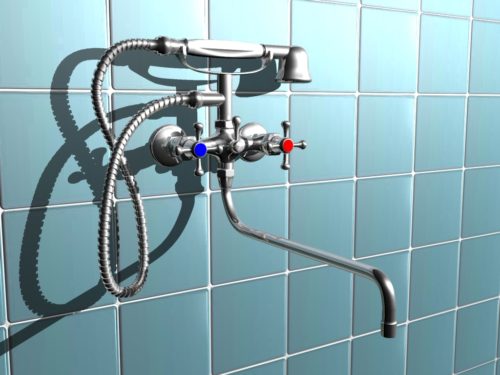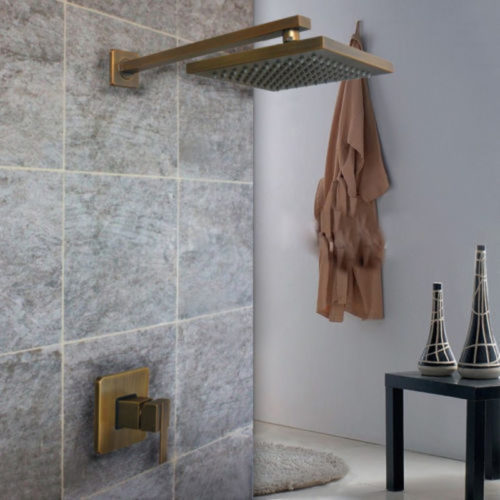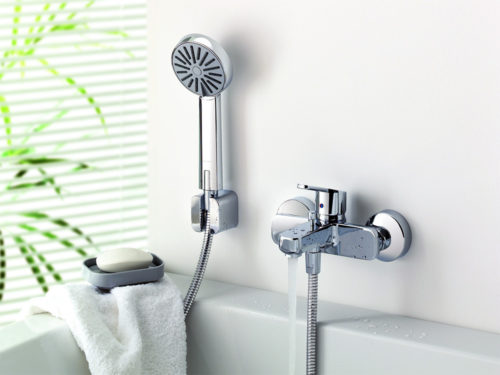The mixers in the bathroom are different. Sometimes it is difficult to determine which mixer is worth choosing: open or hidden. The second option most buyers bypass side, because it is difficult to understand how the water supply device can be hidden in the wall. Therefore, today we will discuss the pros and cons in order to choose a high-quality mixer.
Content
So, let's first find out what is the usual mixer? This is not just a "nose", according to which water flows, this is a rather complicated device that is not only responsible for the flow of water, but also for its temperature, as well as for the flow intensity. It turns out that it is difficult without a mixer and even impossible to do in the bathroom.
If this is a regular device, then the entire mechanism or heart of the mixer will be in sight. Such mixers are massive, occupy a lot of space. Not very presentable look in small rooms. The second option is hidden mixers. It is clear from the name that the entire mechanism and the fastening system will be hidden, and only "Nose" remains in sight.
How to choose a high-quality mixer
Let us consider more in more detail on the example of both embodiments:
This is how the usual mixer looks like. It connects the standard, with adapters (couplings) - on hot and cold water pipes. All these connections are not hiding anywhere, so they remain in sight. They can be hidden except with special linings.
The standard mixer from such elements is:
- levers or valves;
- crane;
- internal mechanism.
By the way, the mechanism itself after developing a resource is subject to replacement. It is very convenient because you can not only save a family budget, but also not to waste time dismantling and installing a new mixer. After all, sometimes to perform it, you will need to remove tile in the bathroom.
And to understand how to replace the cartridge in the mixer, check out the list of major faults:
- If the crane opened, the water supply temperature was set, but the water is fed or too cold, or too hot, it's time to replace the cartridge.
- Adjust the water supply temperature is impossible.
- Fully close the crane does not work, water (cold or hot) flows out of the nose.
- When only hot water flows from the crane, or only cold, even if an attempt was to adjust the water temperature.
If you noticed the faucet failures, it is necessary to replace. And in order to accomplish this work, you need to think in advance about purchasing a high-quality faucet with the cartridge.
But it looks like a built-in mixer in a modern bathroom. Such water supply devices consist of only 2 components: wall mechanism and built-in. Built-in elements are mounted directly into the wall. In order to establish such a mixer, it is necessary to prepare a place for installation in advance - in the wall you need to make a small deepening. Naturally, cold and hot water supply pipes should also be performed in the wall so that such a mixer can be connected.
The decorative part of the built-in mixer is installed after connecting to the water supply system and after the walls are completed in the bathroom. For example, after painting the walls or laying tiles. As a result of the work done, only the outer part of the mixer will be visible. Additional devices are chosen taking into account the needs: valves for hydromassage, soul head, etc.
Varieties of bath mixers
Consider the popular version of the mixer - outdoor. It is often called "long" due to the fact that the spout of the water supply device is elongated. If your bedroom is a standard sample, with a bathroom of standard sizes, as well as a sink, then a variant of installing a conventional outer mixer can be considered. The stable is stolen in such a mixer, in the form of a long curved on the end of the pipe to rotate it in the desired direction. Thus, you can save money and install one mixer that is easy to rotate to dial water into the bath or to take a shower.
Faucet with shower:
The switch at such a mixer with the shower can be different:
- sleeve;
- push-button;
- spool.
Each of the listed options is checked for years, so if you choose on a long-type mixer with a built-in shower, then you can choose anyone you like. If you study consumer reviews, it becomes clear that such mixers are reliable, durable. But if the resource has been exhausted, you will have to replace the old mixer to a new one.
The mixers for the sink are different, consider in more detail each of them:
- Valve mixer. This is a classic, such mixers were popular in the last century. It is 2 valves through which hot water is mixed with cold.
- The lever mixer is a water supply device equipped with a special mechanism: a cartridge or a ball mechanism. To adjust the temperature of the water and the intensity of the pressure, it is necessary to move the lever in the desired direction. For example, to make water comfortable temperature, you need to move the lever horizontally.
- Contactless mixer - water supply due to the fact that special sensors are installed inside the device. To wash your hands, you need to bring them to the mixer, after a few seconds the sensors will work, water is spoiled from the tap.
- Cascade mixer - water is fed under strong pressure, similar to the waterfall. It is not always profitable, especially for home use. Therefore, the last 2 models belong to the VIP-category models. A distinctive feature of such mixers: the original design, model ergonomic, so do not occupy a lot of space. Minus only one is the high cost of such a mixer.
Hygienic shower mixer
Another option of the mixer is a hygienic shower. If there is no possibility to establish a separate personal hygiene device (bidet), then as an alternative you can try to install a hygienic shower mixer. You can place the soul head anywhere: both on the toilet and on the wall. Significantly such a fastening method will not overload the bathroom, and if it is a small room, then the acquisition of a compact mixer with the "hygienic shower" function will be the right solution.
This model consists of a standard mixer, a flexible hose with a small watering can at the end, fitting for installation. To take advantage of the shower, you must click on the shut-off valve, which is located on the handle of the flexible hose. Water supply is carried out by pressing the valve, for this you need to take the handle in the hand. To save money, note that most standard shell models have an extra hole - just in this nest and can be installed a hygienic shower.

Choosing such a mixer, pay attention to the options:
- Mixer with built-in hose and head that can be attached on the wall.
- Mixer, with a fastening option on the sink.
- Mixer built into the toilet or to the toilet bowl.
If there is no possibility to rebuild and reconnect the mixer, then the easiest option is a classic when the hygienic shower is fixed on the wall. If there is a sink next to the toilet, then it's easier to connect the device directly to the stationary mixer.
Hidden mixer. Advantages and disadvantages
Hidden or built-in mixer is comfortable and beautiful. You can forget about the hanging hose, which remains so strive to release a drop-other on the floor, bodice of a bath or sink. No protruding levers - nothing will happen if you choose a high-quality hidden mixer.
The mixer consists of 2 elements: this is a block mounted in a wall and a decorative panel with levers. Elements can be purchased separately, which is very important in the event that your goal is to make the bathroom as harmonious as possible. Therefore, the panel can be purchased separately by choosing not only the color, but also size as well as the form. In addition, you need to choose the scum (or spout), watering can. As for the material of the main, built-in block, it is best that it is a high-quality material, because since it will be built into the wall. Naturally, such a mixer must stop dozens of years, so the cylinder body must be plastic, and the inner head is from brass.
Installing the mixer in the bathroom:
- In order to mount the built-in mixer, you need to make a small niche in the wall. For modern models, it will be enough to deepen by 10 cm (minimum of 8.5 cm), the diameter of the hole in the range of 15 cm. Drive the hole in the wall is easier using the perforator.
- The next step is the laying of pipes. But first you need to make holes and think about where the nose of the mixer will be located and the watering can be installed. From these 2 points, it is necessary to pave the ships so that the pipes for the cold and hot water do not blocked. It is possible and not to make a deepening in the pipe laying, if overhaul is planned in the bathroom and subsequently the walls will be covered with moisture-resistant plasterboard.
- Connecting pipes to the mixer is performed standard, only you need to check several times so that all connections are reliable. For this, experts recommend using a special material: packles or paint. As for the threads or tape, this insulating material is better not to use.
- What is important: if you want the mixer to serve for many years, the metal-plastic pipes are better not to embed into the wall. The win-win version is a copper pipe or polypropylene. All threaded connections need to minimize to eliminate the chance of leaks.
- The next step - at the end of the water pipes, it is necessary to install adapters, after which you can fix them with fasteners (dowels) or put on the solution. It is important to do everything smoothly that then there were no problems with the operation of the mixer.
- The final part is the installation of the panel with levers, the mounting of the nose and shower. The lining must be installed in special grooves until it clicks, install watering can and shower hose. Then check the mixer in action.
Bathroom mixer. Video:























